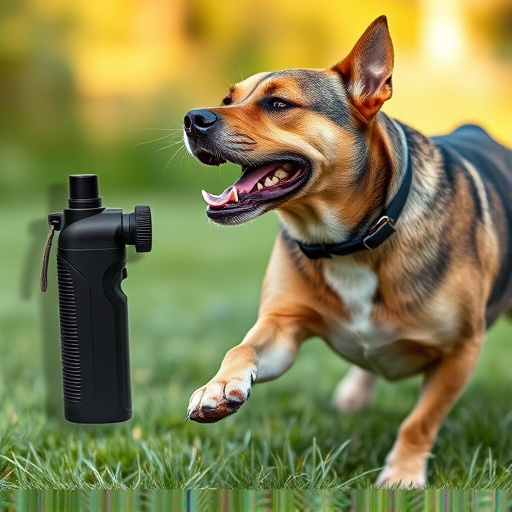Dog pepper spray, powered by capsaicin, acts as a deterrent against aggressive dogs. Concentrations range from 1% to 5%, affecting potency and control. Higher concentrations offer better protection but increase accidental spraying risk and eye irritation. When choosing dog spray, consider capsaicin content, quality, application method, range, durability, and training requirements for informed decisions based on specific needs and scenarios. A Dog Spray Capsaicin Content Comparison is essential to ensure safety and efficacy without causing undue harm.
“Protecting your furry companion and yourself from aggressive dogs is a serious concern, leading many pet owners to explore innovative defense mechanisms. One such tool gaining popularity is dog pepper spray—a potent deterrent designed to stop attacks quickly. This article delves into the world of dog pepper spray, focusing on capsaicin content as the key ingredient for its effectiveness. We’ll compare commercial products, offer training tips, and highlight safety considerations, empowering pet owners with valuable knowledge for effective defense.”
- Understanding Dog Pepper Spray: Ingredients and Effects
- Capsaicin Content: A Key Factor in Defense Spray Effectiveness
- Comparing Commercial Dog Pepper Spray Products
- Training and Safety Considerations for Using Dog Pepper Spray
Understanding Dog Pepper Spray: Ingredients and Effects
Dog pepper spray, also known as canine repellent or dog defense spray, is a tool designed to deter and protect against aggressive dogs. Its primary active ingredient is capsaicin, the same compound that gives chili peppers their heat. The effectiveness of dog spray lies in its ability to cause temporary disorientation and pain, giving the user precious time to escape or defend themselves.
When it comes to understanding dog pepper spray, a key factor is the capsaicin content comparison between different brands. Capsaicin concentration typically ranges from 1% to 2%, though some high-end formulations may have up to 5%. This variation directly impacts the spray’s intensity and reach. A higher capsaicin content generally means a more potent spray, capable of reaching farther distances and causing longer-lasting effects. However, it also increases the risk of accidental spraying and potential eye irritation for the user. Therefore, choosing the right dog spray involves finding a balance between potency and control.
Capsaicin Content: A Key Factor in Defense Spray Effectiveness
The effectiveness of dog pepper spray depends heavily on its capsaicin content—the active ingredient responsible for the spray’s heat and irritant properties. Capsaicin, found in chili peppers, creates a burning sensation when it comes into contact with mucous membranes. In dog sprays, this component is typically measured in milligrams per ounce or percentage.
When comparing different dog sprays, higher capsaicin content generally translates to more intense irritation and longer-lasting effects. However, it’s crucial to consider that not all capsaicin levels are created equal; a spray with 1% capsaicin might have a significantly stronger impact than another with 0.5%, due to the quality and concentration of the capsaicin used. Always check product labels for specific capsaicin content to ensure optimal defensive capabilities when facing potentially aggressive dogs.
Comparing Commercial Dog Pepper Spray Products
When comparing commercial dog pepper spray products, one key factor to consider is the capsaicin content. Capsaicin is the active ingredient responsible for the spicy sensation and immobilizing effects of pepper spray. Products with higher capsaicin concentrations typically offer more potent protection against potential threats. However, it’s important to note that strength doesn’t always equate to safety; higher concentrations may require proper training to handle effectively and could potentially cause adverse reactions in certain dogs.
Additionally, factors like application method, range, and durability of the spray should be taken into account. Some products feature specialized nozzles for targeted spraying, while others offer a wider range for greater coverage. Durability is also crucial; dog pepper sprays designed for outdoor use or aggressive intruders should be built to withstand harsh conditions. Always read product labels and follow manufacturer guidelines for optimal results and safety.
Training and Safety Considerations for Using Dog Pepper Spray
Training is an essential aspect of equipping your dog with the skills needed for self-defense, especially when considering options like pepper spray. It’s crucial to introduce the concept gradually and in a controlled environment. Start by familiarizing your canine companion with the spray can, allowing them to sniff and investigate it without triggering any activation. This helps reduce potential fear or anxiety associated with the object. Use positive reinforcement techniques during training sessions; reward calm behavior and good reactions to the spray’s presence.
When discussing safety, understanding the capsaicin content in dog pepper sprays is vital. Different brands may vary in concentration, and a closer look at product labels can help you choose an option suitable for your needs. A thorough comparison of capsicum content will ensure the spray is effective yet safe for both the dog and potential threats. Remember, proper usage depends on accurate timing and understanding the behavior of both the dog and the target, making training a critical component of any self-defense strategy.
Dog pepper spray can be an effective self-defense tool, but understanding its composition, particularly capsaicin content, is key to ensuring its success. When comparing commercial products, it’s important to consider not only the capsaicin level but also safety and training aspects. Proper training enables users to deploy the spray effectively while minimizing harm to non-threats. By choosing a reputable product and practicing responsible use, individuals can enhance their personal safety in potential dog encounters.
